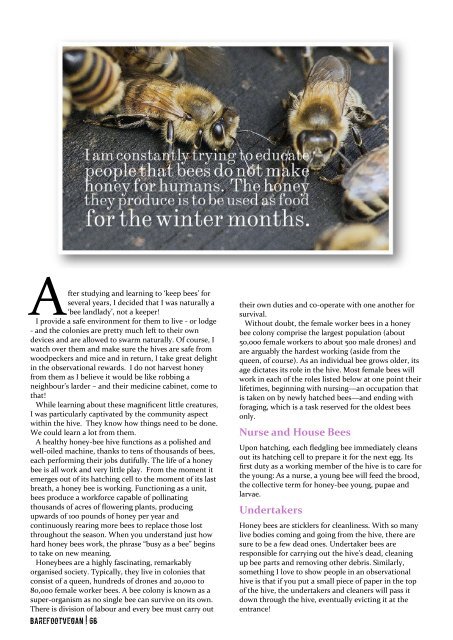Barefoot Vegan Magazine March_April 2017 issue
This issue of Barefoot Vegan Magazine is themed around community. We speak to vegan social justice activist, Brenda Sanders about what motivates her work, her best advice on running effective community outreach programmes and how to avoid burnout. We also feature interviews with London Afro Vegan's Esme, co-founder of Food Not Bombs, Keith McHenry, and we talk about community crowdfunding with One Planet Pizza's Mike Hill. Plus as usual, we've got lots of beautiful and inspiring content from our contributors and a huge selection of delicious vegan recipes.
This issue of Barefoot Vegan Magazine is themed around community. We speak to vegan social justice activist, Brenda Sanders about what motivates her work, her best advice on running effective community outreach programmes and how to avoid burnout.
We also feature interviews with London Afro Vegan's Esme, co-founder of Food Not Bombs, Keith McHenry, and we talk about community crowdfunding with One Planet Pizza's Mike Hill.
Plus as usual, we've got lots of beautiful and inspiring content from our contributors and a huge selection of delicious vegan recipes.
You also want an ePaper? Increase the reach of your titles
YUMPU automatically turns print PDFs into web optimized ePapers that Google loves.
A<br />
fter studying and learning to ‘keep bees’ for<br />
several years, I decided that I was naturally a<br />
‘bee landlady’, not a keeper!<br />
I provide a safe environment for them to live - or lodge<br />
- and the colonies are pretty much left to their own<br />
devices and are allowed to swarm naturally. Of course, I<br />
watch over them and make sure the hives are safe from<br />
woodpeckers and mice and in return, I take great delight<br />
in the observational rewards. I do not harvest honey<br />
from them as I believe it would be like robbing a<br />
neighbour’s larder – and their medicine cabinet, come to<br />
that!<br />
While learning about these magnificent little creatures,<br />
I was particularly captivated by the community aspect<br />
within the hive. They know how things need to be done.<br />
We could learn a lot from them.<br />
A healthy honey-bee hive functions as a polished and<br />
well-oiled machine, thanks to tens of thousands of bees,<br />
each performing their jobs dutifully. The life of a honey<br />
bee is all work and very little play. From the moment it<br />
emerges out of its hatching cell to the moment of its last<br />
breath, a honey bee is working. Functioning as a unit,<br />
bees produce a workforce capable of pollinating<br />
thousands of acres of flowering plants, producing<br />
upwards of 100 pounds of honey per year and<br />
continuously rearing more bees to replace those lost<br />
throughout the season. When you understand just how<br />
hard honey bees work, the phrase “busy as a bee” begins<br />
to take on new meaning.<br />
Honeybees are a highly fascinating, remarkably<br />
organised society. Typically, they live in colonies that<br />
consist of a queen, hundreds of drones and 20,000 to<br />
80,000 female worker bees. A bee colony is known as a<br />
super-organism as no single bee can survive on its own.<br />
There is division of labour and every bee must carry out<br />
<strong>Barefoot</strong><strong>Vegan</strong> | 68<br />
their own duties and co-operate with one another for<br />
survival.<br />
Without doubt, the female worker bees in a honey<br />
bee colony comprise the largest population (about<br />
50,000 female workers to about 500 male drones) and<br />
are arguably the hardest working (aside from the<br />
queen, of course). As an individual bee grows older, its<br />
age dictates its role in the hive. Most female bees will<br />
work in each of the roles listed below at one point their<br />
lifetimes, beginning with nursing—an occupation that<br />
is taken on by newly hatched bees—and ending with<br />
foraging, which is a task reserved for the oldest bees<br />
only.<br />
Nurse and House Bees<br />
Upon hatching, each fledgling bee immediately cleans<br />
out its hatching cell to prepare it for the next egg. Its<br />
first duty as a working member of the hive is to care for<br />
the young: As a nurse, a young bee will feed the brood,<br />
the collective term for honey-bee young, pupae and<br />
larvae.<br />
Undertakers<br />
Honey bees are sticklers for cleanliness. With so many<br />
live bodies coming and going from the hive, there are<br />
sure to be a few dead ones. Undertaker bees are<br />
responsible for carrying out the hive’s dead, cleaning<br />
up bee parts and removing other debris. Similarly,<br />
something I love to show people in an observational<br />
hive is that if you put a small piece of paper in the top<br />
of the hive, the undertakers and cleaners will pass it<br />
down through the hive, eventually evicting it at the<br />
entrance!




